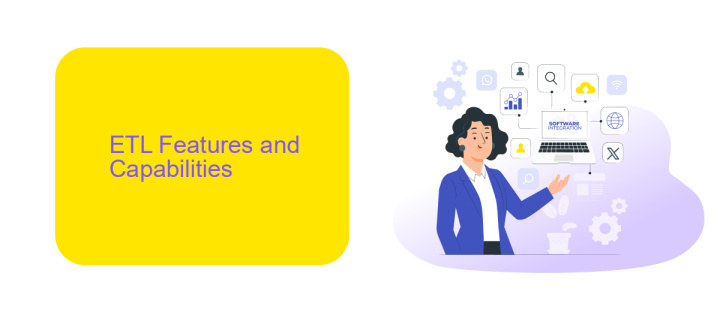Big Data ETL Tool
In today's data-driven world, the ability to efficiently extract, transform, and load (ETL) vast amounts of data is crucial for businesses. Big Data ETL tools play a pivotal role in managing and processing large datasets to provide actionable insights. This article explores the importance of Big Data ETL tools, their key features, and how they can enhance data management strategies.
Introduction
Big Data ETL (Extract, Transform, Load) tools are essential for managing and processing vast amounts of data efficiently. These tools help organizations extract data from various sources, transform it into a suitable format, and load it into a data warehouse or other storage systems for analysis. The importance of ETL tools has grown significantly with the increasing volume, variety, and velocity of big data.
- Data Extraction: Gathering data from multiple sources.
- Data Transformation: Converting data into a usable format.
- Data Loading: Storing data in a centralized repository.
One of the key aspects of modern ETL tools is their ability to integrate with various data sources and applications seamlessly. Services like ApiX-Drive facilitate these integrations by providing a user-friendly platform to connect and automate workflows between different systems. This capability ensures that data can be efficiently processed and utilized, empowering organizations to make data-driven decisions.
ETL Features and Capabilities

ETL tools offer a range of features and capabilities designed to streamline data extraction, transformation, and loading processes. These tools support various data sources, including databases, cloud services, and APIs, ensuring seamless data integration. Advanced ETL tools provide robust data transformation functionalities such as filtering, sorting, and aggregating data, which help in preparing data for analysis. Additionally, they offer automated scheduling and monitoring to ensure data pipelines run efficiently and without interruption, reducing manual intervention and potential errors.
One notable feature of modern ETL tools is their ability to integrate with third-party services to enhance data workflows. For instance, ApiX-Drive allows users to automate data transfer between different applications without coding knowledge. This service facilitates the setup of integrations, enabling users to connect various data sources and destinations effortlessly. With such capabilities, businesses can ensure that their data is always up-to-date and accessible, supporting informed decision-making and operational efficiency.
Benefits and Use Cases

Big Data ETL tools offer a multitude of benefits that can significantly enhance data processing and analytics capabilities for businesses. These tools streamline the extraction, transformation, and loading of large datasets, enabling organizations to make data-driven decisions more efficiently.
- Improved Data Quality: ETL tools standardize and clean data, ensuring accuracy and consistency.
- Time Efficiency: Automating data workflows saves time and reduces manual errors.
- Scalability: These tools can handle increasing volumes of data as businesses grow.
- Integration: Services like ApiX-Drive facilitate seamless integration with various data sources and applications.
- Real-time Processing: ETL tools support real-time data processing, providing up-to-date insights.
Use cases for Big Data ETL tools span multiple industries. In retail, they help analyze customer behavior and optimize inventory. Financial services use them for fraud detection and risk management. Healthcare organizations leverage ETL tools to integrate patient data from various sources for better treatment outcomes. By incorporating services like ApiX-Drive, companies can easily connect disparate systems, ensuring smooth data flow and enhancing overall operational efficiency.
Challenges and Considerations

Implementing a Big Data ETL tool involves numerous challenges and considerations that organizations must address to ensure seamless data integration and transformation processes. One of the primary challenges is handling the sheer volume and variety of data from multiple sources, which can be both structured and unstructured.
Another significant consideration is ensuring data quality and consistency throughout the ETL process. Poor data quality can lead to inaccurate analytics and business insights, which can have detrimental effects on decision-making processes.
- Scalability: Ensuring the ETL tool can handle growing data volumes.
- Performance: Optimizing the ETL process to minimize latency.
- Security: Protecting sensitive data during extraction, transformation, and loading.
- Integration: Seamlessly integrating with various data sources and destinations.
Services like ApiX-Drive can facilitate the integration process by providing automated data transfer and synchronization between different platforms. This reduces the complexity and manual effort involved in setting up and maintaining data pipelines, allowing organizations to focus on deriving actionable insights from their data.
- Automate the work of an online store or landing
- Empower through integration
- Don't spend money on programmers and integrators
- Save time by automating routine tasks
Conclusion
In conclusion, Big Data ETL tools are essential for transforming, loading, and integrating vast amounts of data from various sources. These tools enable organizations to streamline their data workflows, ensuring that data is accurate, accessible, and ready for analysis. By automating complex data processes, businesses can focus on deriving actionable insights, which drive better decision-making and enhance operational efficiency.
Moreover, services like ApiX-Drive play a crucial role in simplifying integrations between different data sources and platforms. ApiX-Drive offers a user-friendly interface and robust features that facilitate seamless data transfer, reducing the need for manual intervention. This not only saves time but also minimizes the risk of errors, ensuring data integrity throughout the ETL process. As the landscape of big data continues to evolve, leveraging such tools and services will be pivotal for organizations aiming to stay ahead in a data-driven world.
FAQ
What is an ETL tool in the context of Big Data?
How does an ETL tool handle large volumes of data?
What are the key features to look for in a Big Data ETL tool?
Can ETL tools integrate with cloud-based data storage solutions?
How can I automate the ETL process for my organization?
Apix-Drive will help optimize business processes, save you from a lot of routine tasks and unnecessary costs for automation, attracting additional specialists. Try setting up a free test connection with ApiX-Drive and see for yourself. Now you have to think about where to invest the freed time and money!


